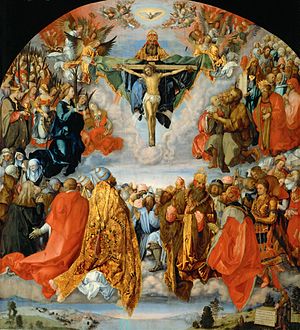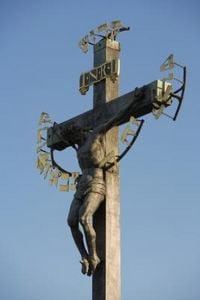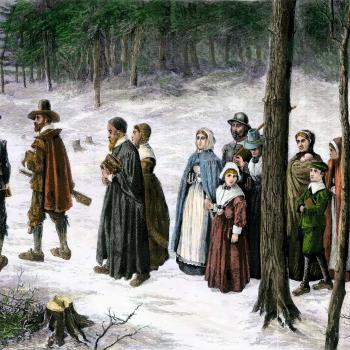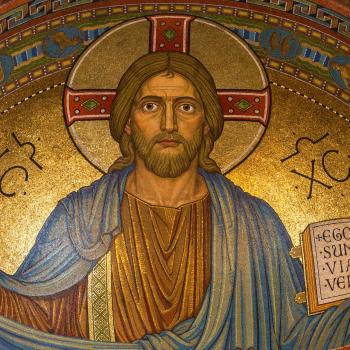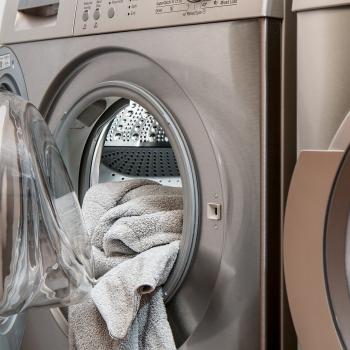I wrote several days ago about how I was attracted to Catholicism because it offered me infallibility immediately after my belief in the infallibility of the Bible had been shaken. A second reason I was attracted to Catholicism was the beauty and ritual it offered.
The first Catholic mass I ever went to was Easter vigil. I went with some Catholic college friends because I was curious. Easter vigil begins at 9:00 p.m. the night before Easter and ends at midnight. It starts outside with a huge bonfire, and then proceeds inside.
(As a side note, Catholics “proceed” completely differently than fundamentalists or evangelicals; there are lighted candles, there is solemn or joyful music, there is incense and collective motion. In a fundamentalist or evangelical church everyone would just walk from point A to point B talking and chatting.)
Anyway, inside there is beautiful music, there are beautiful prayers, there is scripture reading and incense and ceremony. At Easter vigil, catechumens are baptized and join the Church. (This surprised me. People joined the Catholic Church? I thought it only went the other way – people leaving the Catholic Church.) At midnight, I left the church slightly shaken, because what I’d experienced was so beautiful and so fundamentally moving.
At the church I grew up in, church services went like this: Everyone comes in and finds a seat, chatting as they do so. The worship leader and the worship team take the stage and lead the congregation in song for a half hour. Someone comes up and makes announcements. Offering is taken while a final song is sung. The pastor comes in and preaches for half an hour. Then it’s over. We didn’t even have communion more than once every three or four months. Simple, straightforward, plain.
In contrast to the church of my upbringing, the Catholic Church offered beauty and ritual every single week. Communion was treated as something wonderful, something to marvel at, and the mass followed thousands of years of tradition (the Catholic Church literally tries to structure its mass after what we know of the earliest early church meetings from the writings that survive). I was fascinated by the beauty I found, and I delved into Catholic teaching in an effort to understand what it all meant.
I met saints and early church fathers, I learned the meaning behind each step of the mass, I read about the history behind the Eucharist and baptism, and there was something intrinsically compelling about it. I loved the history the Catholic Church offered, and I loved that everything meant something, and often something ancient, something tying me to generations of Catholics. As I came to understand the Eucharist, to understand the reasoning behind infant baptism, to understand the importance of first communion and confirmation, it all fit together into a beautiful experience of collective Christian life that spanned both centuries and nations.
I also loved that the mass and the beliefs were the same no matter what Catholic Church you happened to step into. I first wondered if the Catholic church I was attending at college was an exception, was perhaps the only Catholic Church where people spoke with love and understanding of Jesus and seemed to lead rich spiritual lives, so I tried some other churches and found them to be the same. Every Catholic church practices the same mass and adheres to the same catechism. This was so different from the Protestant churches I was familiar with, where every church taught something different. I loved this universalism. I loved feeling tied together with millions and millions of other Christians by the same prayers and same beliefs.
A lot of fundamentalists see Catholic ritual as something that comes between the Christian and God, blocking what should be a clear and open communication. Actually, I found it to be the opposite. The ritual, the meaning, the connection to other Christians past and present, it all enhanced my understanding of God. Reading the lives of the Saints and talking to them made me feel closer to God, not further from him. (The Catholic Church holds to something called “the communion of the Saints.” Basically, the Saints in heaven can hear what we say to them and are interested in our lives, so when we’re going through something similar to what one of them did, we can talk to them and find comfort in our understanding.) I found that Catholic ritual made my relationship with God more beautiful and more deep, not more cloudy or distant. The history, the millenia of theology and great religious thinkers, the century upon century of role models – I loved it.
I didn’t leave the Catholic Church because I stopped loving all of this. I still do. I still find the Catholic Church attractive, and I still enjoy attending mass now and then. I love the beauty, the depth, the history, the meaning. I left the Catholic Church simply because (a) I found some of its beliefs and practices troubling (i.e. those on sexuality) and (b) certain universal Christian doctrines, like substitutionary atonement and the trinity, stopped making sense to me. I still think the ritual, community, and universality of the Catholic Church is beautiful, and I probably always will.


